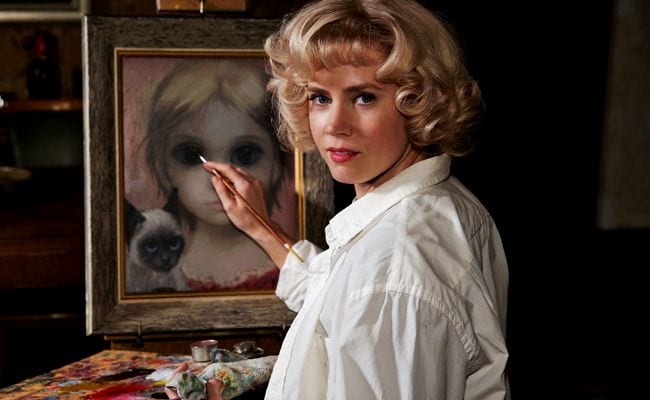
There was a time in the early ’60s when Walter Keane was making more money than any other living artist in the Western world. He was a master of sales, making himself the subject of fawning interviews and Life magazine spreads, sidling up to celebrities for photo ops whenever he could. Originals and, especially, reproductions of his “big eye” paintings were snatched up an adoring public, who didn’t care one bit about the critics who called his work sentimental garbage. His success led to admiration and dissent: Woody Allen’s Sleeper posits a future where the paintings, like Xavier Cugat’s music, are viewed as masterpieces.
As much as that joke is premised on the paintings’ kitsch, it also has to do with their eventually revealed truth, which is that Walter never painted them. In Tim Burton’s fancifully filmed Big Eyes, we’re reminded that his wife Margaret (Amy Adams) was the artist. She’s introduced here a quiet Southern lady who’s leaving a bad marriage. Packing up her young daughter Jane (Delaney Raye) along with her paints. Margaret moves to San Francisco, circa 1958. She has one friend in town, a black-dressed willow of an artist named DeeAnn (Krysten Ritter) who encourages Margaret to spread her wings. But no sooner does Margaret start showing her paintings and doing portraits on the street than another painter gloms on to her, and even more importantly, on to her work.
Walter (Christoph Waltz) is a bon vivant with a story for every occasion and an angle on every person he meets. He romances Margaret with a borderline frightening devotion, his performance plainly over-the-top but also oddly captivating. “I’m just a Sunday painter,” he tells her, vaguely referring to much-missed days in France while admiring her work when they go on afternoon dates with their easels. Wrangling a gallery space in a North Beach jazz club, Walter realizes that Margaret’s slightly creepy paintings of big-eyed waifs grab people’s attention more readily than his own motel-room-style Parisian street scenes. Arguing that people don’t buy “lady paintings”, Walter starts telling everybody her paintings, signed “Keane”, are his. Claiming he’s a wealthy real estate broker, Walter still hustles for every scrap of business or hint of publicity, mostly via his connection to society columnist Dick Nolan (Danny Huston). Walter is a poseur’s poseur, so wrapped up in his own fiction that he explodes in fury at any criticism, as though he believes the art truly is his creation.
While Margaret seems mired in ’50s gender roles, in the film her situation also represents the change to come. For her, freedom is hard won: for a time Walter has her so afraid of losing their fortune that she’s locked in an attic room, churning out paintings like some indentured art servant. She hides the truth from everybody, including Jane and DeeAnn, even as her paintings explode in popularity, sharing her secret only with her puffy dog. Adams plays Margaret with a whispery dignity that’s subtle but utterly sympathetic and intelligent. At no point does she come off as pathetic, only understandably frightened about trying to raise a daughter alone as a single mother. Still, Walter’s ferocious greed grates at her. The film starts to resemble a long fuse; you’re just waiting for that moment when Margaret will finally blow.
That imminent end takes some time to arrive, as Scott Alexander and Larry Karaszewski’s mostly perky screenplay also sets Margaret’s struggle against a broader cultural context. When John Canaday (Terence Stamp), based on the real-life New York Times art critic, proclaims one big-eye painting “an infinity of kitsch”, the room is full of well-dressed elitist patrons, the crowd Walter wants so badly to join but never will. However you might feel about Canaday’s condemnation of the art, the movie uses him here to knock down Walter Keane, who sputters and fumes as if on cue.
At the same time, Margaret’s relentlessly tacky portraits, kids with shimmering eyes, might recall images in Tim Burton’s own sketchbooks. In keeping with the attack on Walter, the movie’s sympathy for Margaret seems a function of its faith in her intentions. She means as well as Walter means ill, and her efforts, however mawkish, are yet weirdly mesmerizing, like Burton’s Jack Skellington or even his version of Ed Wood. Critical judgment and personal taste don’t always coincide. Consider that Big Eyes opens with a quotation from Andy Warhol — “I think what Keane has done is just terrific. If it were bad, so many people wouldn’t like it” — asking us, perhaps, to rethink our own knee-jerk assumptions about mass appeal.
If there is a rebuke here to critics, it is delivered lightly. Big Eyes is not just a smaller scale film than Burton’s Dark Shadows, for example, but also sweeter in its enthusiasms and comedic touch. The film is awash in candy-color hues and framed by Pop Art shapes, courtesy of Amelie cinematographer Burno Delbonnel. The mood is almost as bright as the look, presenting the San Francisco art and jazz scene like a theme park or better, a Disney live-action movie starring Kurt Russell. You can almost imagine him walking into the place and goggling his eyes at all the craaazy action. It’s the right approach, an appreciation rather than an argument. Margaret Keane ends up winning a court case against her husband, a right to self-expression that Tim Burton so frequently celebrates.

